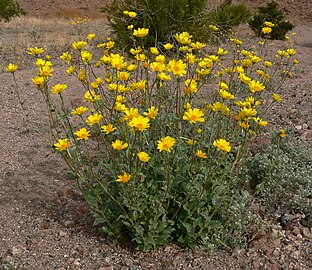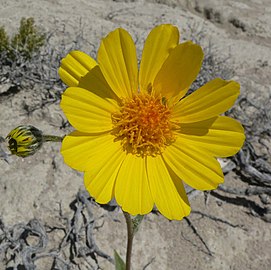Geraea canescens, commonly known as desert sunflower, hairy desert sunflower, or desert gold, is an annual plant in the family Asteraceae. The genus name comes from the Greek geraios ("old man"), referring to the white hairs on the fruits.[2]
G. canescens bears yellow sunflower-like flowers on slender, hairy stems. It grows 0.30–0.91 metres (1–3 feet) high. The leaves are gray-green and grow to 8 centimetres (3 inches) long. It flowers February through May after sufficient rainfall, and sometimes in October and November.[3] The flowers are 5 cm (2 in) wide with 10–20 ray florets, which are each about 2 cm (3⁄4 in) long.[3]
The plant is native to western North America, specifically Arizona, Nevada, California, and Utah. A drought-resistant annual plant, it can be found in the California,[4] Mojave, and Sonoran Deserts. It grows below sea level, from −40 to 1,130 m (−130 to 3,700 ft), in sandy desert soils along with creosote bush (Larrea tridentata).[5] It is one of the flowers which participates in the occasional superblooms of desert flowers.
There are two varieties:
- Geraea canescens var. canescens
- Geraea canescens var. paniculata S.F.Blake
The flowers attract bees and birds, and the seeds are eaten by birds and rodents.[6]
-
G. canescens in Death Valley
-
Flower close-up
-
Seeds
References
- ^ The Plant List, Geraea canescens Torr. & A.Gray
- ^ "Native Plant Database_University of Texas at Austin".
- ^ a b Spellenberg, Richard (2001) [1979]. National Audubon Society Field Guide to North American Wildflowers: Western Region (rev ed.). Knopf. p. 376. ISBN 978-0-375-40233-3.
- ^ "CalFlora Taxon Report".
- ^ "Geraea canescens, Hairy Desertsunflower, Southwest Desert Flora". Southwest Desert Flora. 2020-07-28. Retrieved 2022-07-25.
- ^ "Desert Sunflower - Desert USA".
External links
- Geraea canescens Torr. & Gray. Hairy Desertsunflower. United States Department of Agriculture Plants Profile.
- Geraea canescens. Lady Bird Johnson Wildflower Center, University of Texas
- Picture of Desert Sunflowers in Death Valley
- Geraea canescens in the CalPhotos photo database, University of California, Berkeley
- Map of the Desert Sunflower's range







Recent Comments